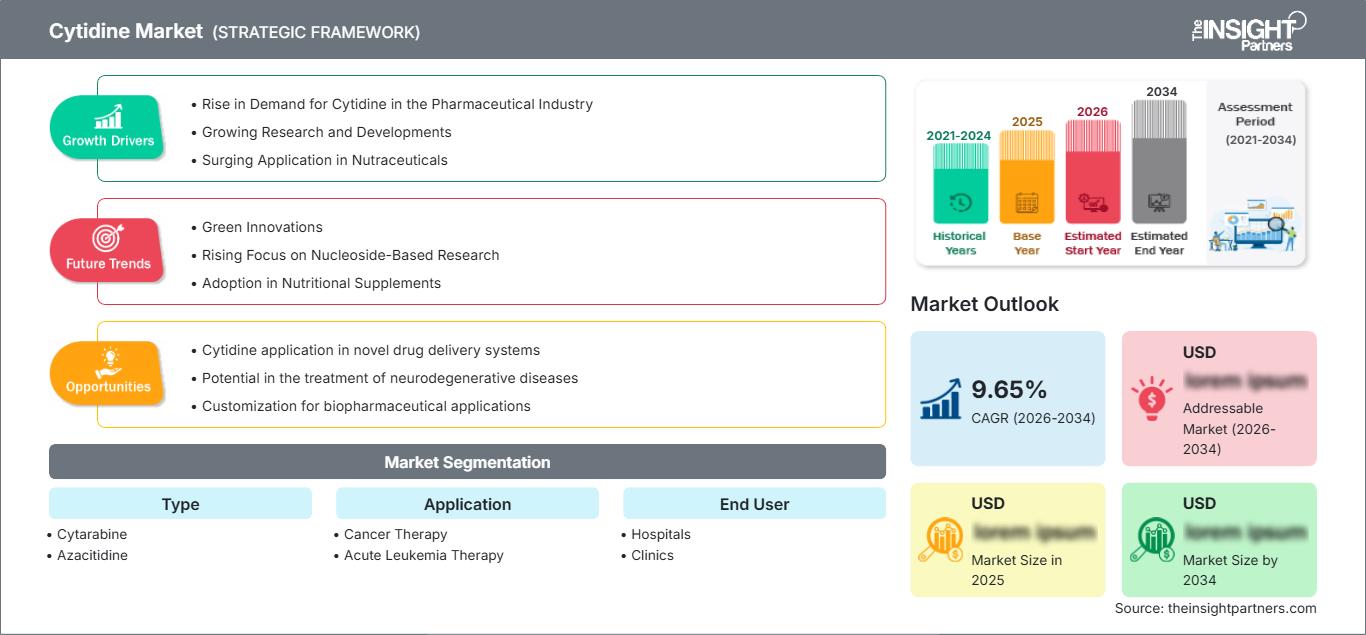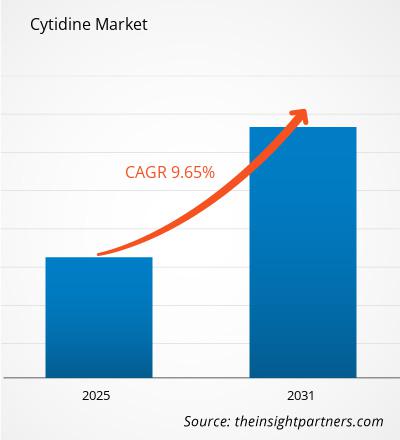Cytidine Market Analysis Research Report (2021-2034)
Historic Data: 2021-2024 | Base Year: 2025 | Forecast Period: 2026-2034Coverage: Cytidine Market covers analysis By Type (Cytarabine, Azacitidine); Application (Cancer Therapy, Acute Leukemia Therapy); End User (Hospitals, Clinics, Others) , and Geography (North America, Europe, Asia Pacific, and South and Central America)
- Report Date : Feb 2026
- Report Code : TIPRE00016640
- Category : Life Sciences
- Status : Upcoming
- Available Report Formats :


- No. of Pages : 150
The Cytidine Market is anticipated to expand at a CAGR of 9.65% from 2026 to 2034. Market conditions continue to evolve, leading to new opportunities for stakeholders. The overall landscape reflects stable progress and long-term growth potential.
The research report is categorized by type into the following subsegments: Natural Cytidine and Synthetic Cytidine. It further presents an analysis based on application, including Pharmaceuticals, Research & Development, and Others. Additionally, The report evaluates end-users, such as Pharmaceutical Companies, Biotechnology Firms, and Research Institutions. The global analysis is broken down at the regional level and major countries, covering key regions like North America, Europe, Asia Pacific, the Middle East & Africa, and South America. The market evaluation is presented in US$ for the above segmental analysis.
Purpose of the Report
The report Cytidine Market by The Insight Partners aims to describe the present landscape and future growth, top driving factors, challenges, and opportunities. This will provide insights to various business stakeholders, such as:
- Technology Providers/Manufacturers: To understand the evolving market dynamics and know the potential growth opportunities, enabling them to make informed strategic decisions.
- Investors: To conduct a comprehensive trend analysis regarding the market growth rate, market financial projections, and opportunities that exist across the value chain.
- Regulatory bodies: To regulate policies and police activities in the market with the aim of minimizing abuse, preserving investor trust and confidence, and upholding the integrity and stability of the market.
Cytidine Market Segmentation Type
- Cytarabine
- Azacitidine
Application
- Cancer Therapy
- Acute Leukemia Therapy
End User
- Hospitals
- Clinics
You will get customization on any report - free of charge - including parts of this report, or country-level analysis, Excel Data pack, as well as avail great offers and discounts for start-ups & universities
Cytidine Market: Strategic Insights

-
Get Top Key Market Trends of this report.This FREE sample will include data analysis, ranging from market trends to estimates and forecasts.
Cytidine Market Growth Drivers
- Rise in Demand for Cytidine in the Pharmaceutical Industry: Cytidine acts as a construction element to create nucleoside analog medicines which treat cancer plus viral and neurological diseases. More people getting sick with these diseases drives up the demand for cytidine in making different types of pharmaceutical products. RNA's natural metabolic and production processes make it essential for medical research and therapeutic development.
- Growing Research and Developments: Research activities in biotechnology and molecular biology drive cytidine demand for medical discovery projects and genetic projects. People use cytidine more because it helps create RNA which leads to research breakthroughs in genomics and personalized medicine thus boosting market need.
- Surging Application in Nutraceuticals: People now use cytidine to develop both dietary supplements and products that protect the brain. Research shows cytidine offers benefits for remembering better and helps brain function while showing promise in treating Alzheimer's disease. People are now using cytidine more in dietary supplements and functional foods because they want better brain health and mental performance.
Cytidine Market Future Trends
- Green Innovations: Dental product consumers are now made up of a large group of Baby Boomer patients. Green or ecological innovations include both dental operative unit and dental operative production changes to reduce environmental impact plus the addition of electronic components to meet computerized system needs.
- Rising Focus on Nucleoside-Based Research: Modern biotechnology tools help scientists study cytidine nucleosides more deeply. Scientists use cytidine to study RNA functions while making gene edits and creating new RNA types. Research and development activities need more cytidine because of increased RNA-based therapeutic development including mRNA vaccines and RNA interference tools.
- Adoption in Nutritional Supplements: Supplement companies use cytidine more often to develop products that help people think better and protect their brain health. People take citicoline supplements to help their memory and concentration, especially during their senior years. People are buying more health and wellness products which makes cytidine supplements grow bigger in the business world.
Cytidine Market Opportunities
- Cytidine application in novel drug delivery systems: Advanced drug delivery technology helps cytidine work better through nanocarriers and liposomes. Advanced drug delivery systems help cytidine-based treatments work better in targeted therapy by improving drug absorption and performance. The new cytidine breakthrough should receive more funding to develop its research and medical applications.
- Potential in the treatment of neurodegenerative diseases: Markets for neurodegenerative disease treatments offer strong growth potential for cytidine because it helps maintain brain health and repair damaged cells. Researchers continue to study how cytidine protects the brain and improves thinking skills which makes it a promising candidate for medical treatments.
- Customization for biopharmaceutical applications: Biopharmaceutical companies want to deliver unique solutions that match their multiple research and manufacturing operations. The producer side requires creating personalized cytidine products to assist researchers working with mRNA synthesis and genetic engineering techniques.
The regional trends and factors influencing the Cytidine Market throughout the forecast period have been thoroughly explained by the analysts at The Insight Partners. This section also discusses Cytidine Market segments and geography across North America, Europe, Asia Pacific, Middle East and Africa, and South and Central America.
Cytidine Market Report Scope
| Report Attribute | Details |
|---|---|
| Market size in 2025 | US$ XX Million |
| Market Size by 2034 | US$ XX Million |
| Global CAGR (2026 - 2034) | 9.65% |
| Historical Data | 2021-2024 |
| Forecast period | 2026-2034 |
| Segments Covered |
By Type
|
| Regions and Countries Covered |
North America
|
| Market leaders and key company profiles |
|
Cytidine Market Players Density: Understanding Its Impact on Business Dynamics
The Cytidine Market is growing rapidly, driven by increasing end-user demand due to factors such as evolving consumer preferences, technological advancements, and greater awareness of the product's benefits. As demand rises, businesses are expanding their offerings, innovating to meet consumer needs, and capitalizing on emerging trends, which further fuels market growth.

- Get the Cytidine Market top key players overview
Key Selling Points
- Comprehensive Coverage: The report comprehensively covers the analysis of products, services, types, and end users of the Cytidine Market, providing a holistic landscape.
- Expert Analysis: The report is compiled based on the in-depth understanding of industry experts and analysts.
- Up-to-date Information: The report assures business relevance due to its coverage of recent information and data trends.
- Customization Options: This report can be customized to cater to specific client requirements and suit the business strategies aptly.
The research report on the Cytidine Market can, therefore, help spearhead the trail of decoding and understanding the industry scenario and growth prospects. Although there can be a few valid concerns, the overall benefits of this report tend to outweigh the disadvantages.
Frequently Asked Questions
What is the expected CAGR of the Cytidine Market?
What are the driving factors impacting the Cytidine Market?
What are the future trends in the Cytidine Market?
Which are the key players in the Cytidine Market?
What are the deliverable formats of Cytidine Market report?
What are the options available for the customization of this report?
Mrinal is a seasoned research analyst with over 8 years of experience in Life Sciences Market Intelligence and Consulting. With a strategic mindset and unwavering commitment to excellence, she has built deep expertise in pharmaceutical forecasting, market opportunity assessment, and developing industry benchmarks. Her work is anchored in delivering actionable insights that empower clients to make informed strategic decisions.
Mrinal’s core strength lies in translating complex quantitative datasets into meaningful business intelligence. Her analytical acumen is instrumental in shaping go-to-market (GTM) strategies and uncovering growth opportunities across the pharmaceutical and medical device sectors. As a trusted consultant, she consistently focuses on streamlining workflow processes and establishing best practices, thereby driving innovation and operational efficiency for her clients.
- Historical Analysis (2 Years), Base Year, Forecast (7 Years) with CAGR
- PEST and SWOT Analysis
- Market Size Value / Volume - Global, Regional, Country
- Industry and Competitive Landscape
- Excel Dataset
Testimonials
The Insight Partners' SCADA System Market report is comprehensive, with valuable insights on current trends and future forecasts. The team was highly professional, responsive, and supportive throughout. We are very satisfied and highly recommend their services.
RAN KEDEM Partner, Reali Technologies LTDsI requested a report on a very specific software market and the team produced the report in a few days. The information was very relevant and well presented. I then requested some changes and additions to the report. The team was again very responsive and I got the final report in less than a week.
JEAN-HERVE JENN Chairman, Future AnalyticaWe worked with The Insight Partners for an important market study and forecast. They gave us clear insights into opportunities and risks, which helped shape our plans. Their research was easy to use and based on solid data. It helped us make smart, confident decisions. We highly recommend them.
PIYUSH NAGPAL Sr. Vice President, High Beam GlobalThe Insight Partners delivered insightful, well-structured market research with strong domain expertise. Their team was professional and responsive throughout. The user-friendly website made accessing industry reports seamless. We highly recommend them for reliable, high-quality research services
YUKIHIKO ADACHI CEO, Deep Blue, LLC.This is the first time I have purchased a market report from The Insight Partners.While I was unsure at first, I visited their web site and felt more comfortable to take the risk and purchase a market report.I am completely satisfied with the quality of the report and customer service. I had several questions and comments with the initial report, but after a couple of dialogs over email with their analyst I believe I have a report that I can use as input to our strategic planning process.Thank you so much for taking the extra time and making this a positive experience.I will definitely recommend your service to others and you will be my first call when we need further market data.
JOHN SUZUKI President and Chief Executive Officer, Board Director, BK TechnologiesI wish to appreciate your support and the professionalism you displayed in the course of attending to my request for information regarding to infectious disease IVD market in Nigeria. I appreciate your patience, your guidance, and the fact that you were willing to offer a discount, which eventually made it possible for us to close a deal. I look forward to engaging The Insight Partners in the future, all thanks to the impression you have created in me as a result of this first encounter.
DR CHIJIOKE ONYIA MANAGING DIRECTOR, PineCrest Healthcare Ltd.Reason to Buy
- Informed Decision-Making
- Understanding Market Dynamics
- Competitive Analysis
- Identifying Emerging Markets
- Customer Insights
- Market Forecasts
- Risk Mitigation
- Boosting Operational Efficiency
- Strategic Planning
- Investment Justification
- Tracking Industry Innovations
- Aligning with Regulatory Trends




















 Get Free Sample For
Get Free Sample For